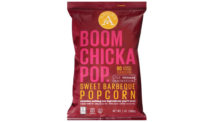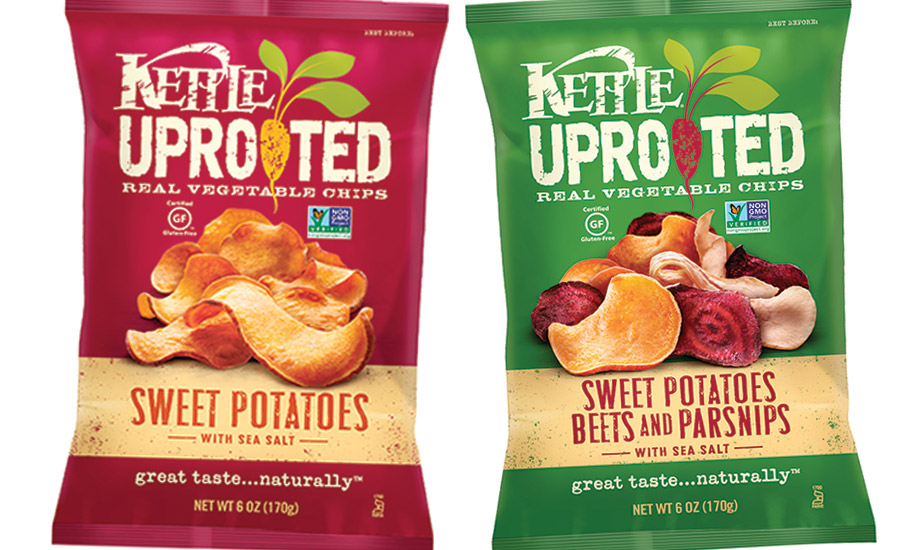New products drive chip sales forward: State of the Industry 2016
Potatoes find new companions in the chips segment as sales of apple chips soar and more root vegetables go into the mix.

courtesy of Snyder’s-Lance

courtesy of Seneca Foods Corp.

courtesy of PepsiCo



courtesy of Snyder’s-Lance

courtesy of Snyder’s-Lance


Chip Sales

Chip Sales










The chips segment has grown quite lively over the past year, with new product areas emerging and others, like apple chips, seeing considerable growth and maturation. Snack producers are also starting to grow beyond potatoes, offering sweet potato, beet and parsnip chips.
Overview | Chips | Puffed/Extruded Snacks | Popcorn | Snack Mixes & Nuts | Tortilla Chips | Pretzels | Frozen Snacks | Crackers
Meanwhile, core traditional chip brands remain solid performers, even as they expand their reach into better-for-you, clean-label and other points of differentiation.
Market data
The potato chip market is the largest within the $21.9 billion salty snacks category, posting modest growth of 1.05 percent in dollar sales for the 52 weeks ending April 17, 2016, per IRI, now valued at $7.3 billion. PepsiCo’s Frito-Lay business maintains a commanding lead in the segment with $4.3 billion in sales for the year and dollar sales slightly down by 0.13 percent.
Snyder’s-Lance posted the best dollar-sales growth for the year, up 8.48 percent to $322.0 million. Diamond Foods (now a Snyder’s-Lance business) saw its chip business grow by 6.70 percent in dollar sales, led by natural chip producer Kettle Brand.
For second consecutive year, apple chips have posted dollar sales growth over 40 percent, up 40.13 percent for the recent 52-week period, growing to $18.3 million (up from $9.4 million last year). Several new companies have entered the segment, but Seneca Foods Corp. still holds commanding control with $10.3 million in sales. Expect the competition to intensify as brands jockey for position in this lucrative emerging segment over the coming year.
Looking back
Flagship PepsiCo/Frito-Lay potato chip brand Lay’s grew by 2.22 percent for the year, taking in $2.2 billion. Lay’s has favored flavor crowdsourcing as a marketing tactic over the last few years, and for 2016 ran a “Flavor Swap” promotion where fans voted for either classic or new flavors to stay in the lineup. In the end, fans voted for the classic flavors—Flamin’ Hot, Cheddar & Sour Cream, Honey Barbecue and Kettle Cooked Sea Salt & Cracked Pepper—to stay in the lineup instead of new flavors like Fiery Roasted Habanero, Smoked Gouda & Chive, Korean Barbecue and Kettle Cooked Olive Oil & Herbs.
Jud McLester, executive chef, ingredient sales manager, McIlhenny Company, TABASCO brand, Avery Island, LA, sees such interaction between a brand and its fans as a key strategic development. He also points toward baked chips and clean-label as trends worth noting.
“Advancements in non-fried applications have allowed for a healthier product with outstanding taste,” says McLester, “thus driving sales.”
The No. 2 chip brand, Ruffles, also continues to find favor, up 6.44 percent to $751.4 million. Better-for-you Baked Ruffles products also trended forward, up 6.86 percent in dollar sales to $61.9 million.
Cape Cod potato chips, a Snyder’s-Lance brand, grew by 8.88 percent for the year to $239.0 million. The brand recently released two limited-batch flavors of potato chips: Smoked Gouda and Roasted Black Garlic.
McLester notes that an emerging trend in potato chips is “bold combinations of sweet and spicy flavors, along with spins on modern classic taste profiles that are not necessarily found in the snack segment.”
Chip producers are also experimenting with alternative substrates. “This year, the category has seen a major shift in the use of alternative oils and different base products, including root vegetables like beets and parsnips,” says Laura Merritt, senior director of marketing, Kettle Brand, Charlotte, NC. Kettle Brand’s new Uprooted line features a Sweet Potato product, as well as a mix of Sweet Potatoes, Beets and Parsnips. “These products have just three ingredients: sliced root vegetables, oil and sea salt,” she says.
Better-for-you simplicity is clearly gaining ground in chips. Seneca Foods Corp.—which in June saw its stock hit an all-time high—now offers its Apple Chips in a wide range of flavors, including caramel and cinnamon, and featuring apple varieties like Golden Delicious and Granny Smith. The company also offers Pear Chips and Sweet Potato Chips.
Oil types are also highlighted on chip packaging today. “We also added a line of kettle-cooked potato chips cooked in 100 percent avocado oil and seasoned with infused salts,” says Merritt. “This new line includes: Himalayan Salt, Chili Lime with Citrus Infused Sea Salts, and Hawaiian Barbeque with Ginger Infused Sea Salts.” The new Kettle Brand lines are Non-GMO Project Verified and Gluten-Free Certified.
“Recently, there has been a surge in new product launches of mixed flavors and/or products,” says Mark Lozano, sales manager, North America, tna, Coppell, TX. “This trend toward mixed packages means manufacturers must run various flavors and/or products within one packaging unit.” To help snack producers respond to this demand, tna recently introduced a new blending system for the tna roflo 3 conveyor that eliminates the need for separate (and expensive) weigher/mixing systems.
Looking forward
The chips market will continue to see product introductions featuring unique vegetable bases. “We expect to see more unexpected vegetables and better-for-you oils,” says Merritt. “We also expect to see unique flavor combinations on new vegetable formats, as well, which have been fairly limited to sea salt variations. In fact, we’re working on a number of unique flavor extensions to our Uprooted line now that we hope to be able to bring to consumers later this year.”
Lozano notes a rising global demand for convenience foods, along with a prioritization of health-and-wellness. “Snack manufacturers are catering to this demand by incorporating alternative ingredients and raw materials,” he says. “In line with this, fruit and vegetable-based snacks are on the rise, as banana, kiwi, kale and coconut chips become increasingly popular amongst consumers. In addition to this, we continue to see more and more consumers opting for smaller, snack-size bags as they look to control their portions and monitor calorie intake. This has an effect on the packaging speeds of production lines, as manufacturers need to package the same amount of product in more bags to retain their production volumes. As a result, we now see packaging systems that can potentially handle up to 250 bags per minute, which is a massive step up in terms of throughput.”
Using vacuum frying, snack producers can process fruit and vegetable chips that are high in natural sugars, such as parsnips, beets, carrots, apples, kiwifruit or mango, by continuously cooking products under low-temperature, low-pressure conditions. “At these low temperatures, temperature-related reactions, such as acrylamide formation, are slowed down significantly and in some cases do not occur,” says Lozano. “At the same time, the degradation of the product’s surface structure is reduced, lowering the amount of oil absorbed and, therefore, enabling significant fat reduction with minimal impact on product quality, including taste and texture. This allows producers to meet consumer trends for healthier and low-fat products with positive organoleptic properties.”
Clean-label is also gaining favor in chips. “From our perspective, selection and use of non-GMO ingredients continues to be the primary force in terms of what is driving interest and sales in the category,” says Merritt.
“There is a real place for creativity in today’s industry, opening up an array of opportunities for novel food processing techniques,” says Lozano. “In particular, non-thermal technologies continue to evolve. Pulsed electric field (PEF) technology, for example, is a relatively new technique that has been developed to successfully reduce the levels of acrylamide in fried snack products, as well as create products lower in saturated and trans fats. The process is particularly suitable for processing raw materials containing high sugar levels, such as fruit and some root vegetables. As such, this type of technology offers manufacturers the possibility to cater to growing consumer demand for natural, low-fat, high-quality snacks, including fruit and vegetable chips.”
As consumer preferences for chips continue to grow more diversified, supreme snack production flexibility will emerge as a prized asset to drive business forward.
Overview | Chips | Puffed/Extruded Snacks | Popcorn | Snack Mixes & Nuts | Tortilla Chips | Pretzels | Frozen Snacks | Crackers
Looking for a reprint of this article?
From high-res PDFs to custom plaques, order your copy today!
















